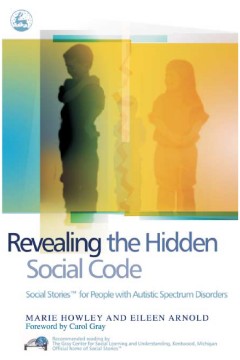
Additional Information
Book Details
Abstract
The Social Stories(TM) approach is widely acknowledged as a key technique for teaching social and life skills to children with autistic spectrum disorders. This text, endorsed by the originator of Social Stories(TM), Carol Gray, offers clear and comprehensive guidance for professionals, parents and carers on how to write successful and targeted Social Stories(TM) that will help develop the autistic spectrum child's understanding of social interaction.
The book outlines the kinds of social challenges that people with ASD may experience and highlights the importance of learning social skills in meaningful contexts. An extended review of the guidelines for writing Social Stories(TM) will help writers to structure and develop their stories. The authors explain the key elements and highlight the potential difficulties that a writer may encounter, while providing encouragement and guidance through the various stages of what is often a challenging process. They include examples from their own professional experience, and suggest ways in which the Social Stories(TM) approach may enhance other strategies. Helpful advice on presentation and implementation is provided.
Revealing the Hidden Social Code is essential reading for any professional, parent, carer or teacher wanting to employ Social Stories(TM) to develop social understanding in people with ASDs.
Howley (Univ. Coll. Northampton, U.K.) and Arnold (Northamptonshire Soc. for Autism, U.K.) have written an excellent supplement to Gray's The New Social Story Book and My Social Stories Book (with Abbie Leigh White and Sean McAndrew); parents, caregivers, and professionals will find clear and succinct instructions for writing their own Social Stories, including helpful examples that convey increasingly complicated messages and yet are still effective for children with ASD. Strongly recommended for all public and academic libraries with autism or education collections.
Library Journal
Revealing the Hidden Social Code is a book about the social stories approach for people with autism spectrum disorders (ASDs), which was originated by Carol Gray. The book describes how social stories may be used, in conjunction with other approaches, to help individuals with ASD to identify the underlying message that underpin social interaction. Excellent case examples are given, throughout the book, to illustrate the development of social stories. It also covers presenting, implementing and monitoring the individual's response and the different types of social stories, which can be used. The book is encouraging to the reader throughout and there is a helpful chapter on what to do when social stories do not work. The appendix contains useful checklists for each stage of preparing the stories, including drafting the social stories, monitoring individual's progress and a checklist for problem solving.
Occupational Therapy Journal
This is a text which aims to identify why social stories work as a strategy to support the social learning of individuals with autistic spectrum disorders (ASD). In its Forward, the original creator of social stories, Carol Gray, strongly endorses this publication.
British Journal of Special Education
This work provides clear and succinct instructions for writing one's own Social Stories, including helpful examples that convey increasingly complicated messages and yet are still effective for children with ASD.
Library Journal
As a practical guide for those who want to learn more about the use of social stories and how to write them, this book could be a valuable resource. With practical suggestions and examples Howley and Arnold explore the strategy's potential for a range of ages, needs and abilities as well as for use in the other learning contexts.
British Journal of Special Education
This is a clearly presented, comprehensive and interesting book for professionals and parents or carers of people with Autistic Spectrum Disorder. It explains the key elements of Social StoriesTM, which are increasingly being used to develop social skills and social understanding. I highly recommend this book to teachers, speech and language therapists and parents or carers who wish to structure and deliver Social StoriesTM to help people with ASD address everyday social challenges.
NAPLIC Newsletter
The writing style is just right - very clear and detailed without being long-winded or laborious. It is a very practical guide and the kind of book that a professional would want to keep within easy reach whenever a social story is needed. Everything you ever need to know about writing a social story seems to have been addressed here and the examples of social stories are very enlightening too. What I really liked about the examples was that a lot of thought and understanding had gone into choosing very different individuals.The writers have obviously had plenty of hands-on experience which enables them to write about the differing needs of individuals with ASDs. This is an excellent and practical guide for anyone attempting to write or simply understand the concept of social stories, how they work and their essential place in the social education of individuals with ASDs.
Good Autism Practice
Marie Howley is a senior lecturer with the Centre for Special Needs Education and Research (SESNER) team at University College Northampton. She has extensive experience as a specialist teacher working with children and adults with autistic spectrum disorders and has co-authored many books, including Accessing the Curriculum for Pupils with Autistic Spectrum Disorders. Eileen Arnold is a former specialist speech and language therapist. She has extensive practice of using Social StoriesTM in a wide range of settings and has worked closely with Carol Gray. She is currently consultant to, and lectures and presents for the Northamptonshire Society for Autism.
